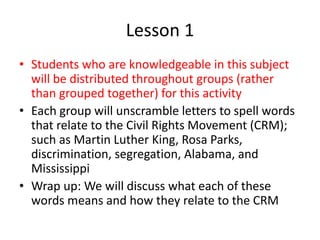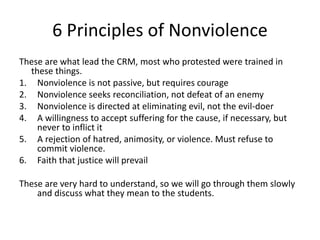Civil rights unit
- 1. Civil Rights Unit 5th grade Social Studies Unit By Lauran Rose
- 2. Sample Pretest âĒ Tell me what you know about Martin Luther King, Jr. âĒ Tell me what you know about Rosa Parks âĒ What does segregation mean? âĒ What is the Civil Rights Movement? When/where did it take place? âĒ What was a sit-in? âĒ What does discrimination mean? âĒ Students who score above 90% will be asked if they would like to do extension work.
- 3. End of Unit Project âĒ All students will do an end of the unit project which will be presented at the beginning so they can start thinking about what they would like to do; the options are: 1. Put yourself in the time of the Civil Rights Movement (CRM), how do you think Jim Crow laws would have affected the life of you and your family? 2. Write a diary from the perspective of one of the CRMâs key individuals (Rosa Parks, MLK, Emmett Till) 3. Write a paper on a key city or event of the CRM. How did this event or city change the course of the CRM?
- 4. Extension Project âĒ TAG students will do an extension project which they will have time to research and complete when they have finished the class assignment (they will be excused from some lessons but occasionally they will join the rest of the class). âĒ Do two of the listed assignments or represent your project in a thoughtful and descriptive way. Options include, but are not limited to: Crossword puzzles, diorama, picture dictionary, mobile, interview, newspaper article, poem, map, skit, presentation using the computer, or finding an interactive and educational website for the class to explore.
- 5. Protesters
- 6. Lesson 1 âĒ Students who are knowledgeable in this subject will be distributed throughout groups (rather than grouped together) for this activity âĒ Each group will unscramble letters to spell words that relate to the Civil Rights Movement (CRM); such as Martin Luther King, Rosa Parks, discrimination, segregation, Alabama, and Mississippi âĒ Wrap up: We will discuss what each of these words means and how they relate to the CRM
- 7. Lesson 2 âĒ Examining newspapers and magazines from the CRM period. âĒ Students will be in the same groups as the previous lesson and will examine some of the pictures and articles from the CRM. âĒ Wrap up: We will answer, âwhat exactly was the Civil Rights Movement?â Students will be given a bus ticket and told to hold onto it for the next day.
- 10. 6 Principles of Nonviolence These are what lead the CRM, most who protested were trained in these things. 1. Nonviolence is not passive, but requires courage 2. Nonviolence seeks reconciliation, not defeat of an enemy 3. Nonviolence is directed at eliminating evil, not the evil-doer 4. A willingness to accept suffering for the cause, if necessary, but never to inflict it 5. A rejection of hatred, animosity, or violence. Must refuse to commit violence. 6. Faith that justice will prevail These are very hard to understand, so we will go through them slowly and discuss what they mean to the students.
- 11. Lesson 3: Bus Boycott âĒ Students will be given a white or black paper plate, we will make masks and wear them for this activity. âĒ The classroom will be set up as if it were a bus, the white plate students will be told a secret (to not let black plate students sit by them or sit in the front of the bus). âĒ Wrap up: We will discuss how this relates to the CRM and what Rosa Parks did, also discuss segregation and look at some pictures of segregated areas. âĒ Assignment: How would you feel if you were a white person during segregation? How would you feel if you were African American? Start thinking about an aspect of the CRM that you might want to research. You will be sharing your findings with the class.
- 12. Freedom Rides
- 13. Freedom Rides
- 15. Lesson 4: Marches/Rallies of the CRM âĒ Watch some footage of marches/rallies and discuss the importance of them to the CRM âĒ Specifically we will look at; the march from Selma to Montgomery for voting rights, Freedom Rides for voting rights, and the March on Washington for all rights (we will look at the stats of these marches; how many people attended, what the outcome was) âĒ Assignment: answer this question: âWhat do you think was the most important march? Why?â And âWhat is something we could march about in our school? What could we protest about?â âĒ Work on extension project.
- 16. Lesson 5: Mock Protest âĒ Students will create posters to protest something we decided on in class âĒ We will march around the play yard while administrators and other teachers look on âĒ We will be practicing a silent, peaceful protest just like the individuals in the CRM âĒ Assignment: Now that we have practiced a protest, how do you think the African Americans in the CRM felt when they were abused for protesting silently and peacefully? Work on extension project (check in with Ms. Rose today)
- 18. Lesson 6: Martin Luther King and the Media âĒ Examine pictures that were posted in magazines and newspapers across the country âĒ Discuss the usage of the media during the CRM âĒ Assignment: How was the media used during the CRM? How were white people portrayed? How were African Americans portrayed?
- 19. Lesson 7- Roles of the Civil Rights Movement âĒ We will discuss the roles of African American citizens, African American baptists, the governor of Mississippi and Alabama, and Protestors âĒ We will list issues and discuss each groupâs role âĒ Students will write an editorial for a newspaper representing one of the groups. Write from another groupâs perspective or work on extension project.
- 20. Lesson 8- Rights of Mankind âĒ Students will interpret social, legal, and political definitions of Civil Rights. âĒ Together, we will come up with a definition of the words âcivil rightsâ âĒ Assignment: What do Civil Rights mean to you? Work on extension project.
- 21. Lesson 9- A Time for Justice âĒ Two weeks prior, a permission slip will have been sent home to watch the documentary âA Time for Justiceâ âĒ We will watch the movies and see what we have been studying, afterwards we will have a very deep conversation about how the students felt and which questions they may have. âĒ Students will participate with the whole class today. No extension project work.
- 22. Questions to Lead Discussion What did you find most striking about the civil rights movement? What surprised or confused you? What were the goals of the civil rights movement? What were the strategies of the movementâs participants? In what ways did the civil rights movement succeed? What made those successes possible? What remains to be done to create a truly just and equitable society? What questions do you still have about the civil rights movement?
- 23. Lesson 10- Successes of the CRM âĒ Integrated buses in Montgomery, AL. âĒ Civil Rights Act of 1964 âĒ The Voting Rights Act of 1965 âĒ Federal troops help desegregate schools âĒ Assignment: Which of these successes do you feel is most important? Check in with Ms. Rose today.
- 24. Lesson 11- The work that still remains âĒ Examine the rates of African American imprisonment, education, and pay compared to other ethnicities. âĒ Assignment: Does a gap still remain? How can we fix this? How can you make society more just? Work on extension activity.
- 25. End of Unit Project âĒ Projects will be due a week after the unit is complete, everyone will have a chance to share. âĒ Everyone will also have the chance to represent their projects (as TAG students are doing) but if they do not have time in class then they must find other time to do it. Such as recess or lunch or at home.


























